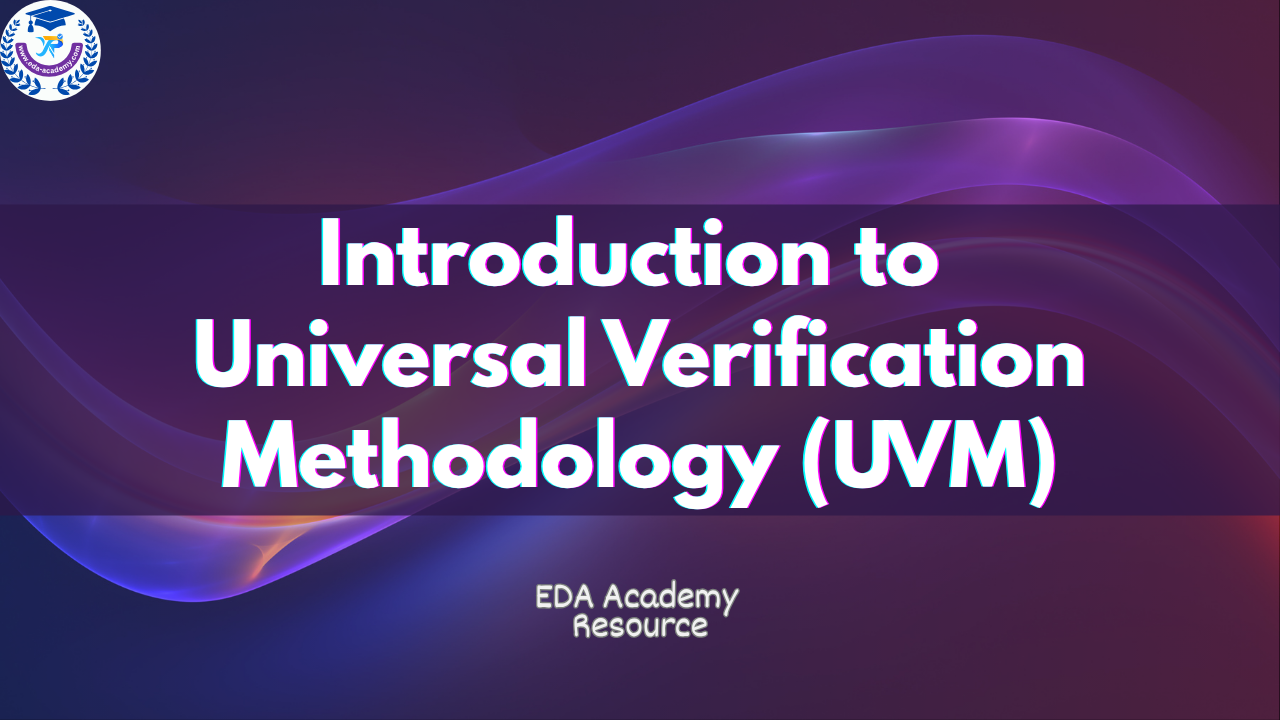Resource:
Introduction to Universal Verification Methodology (English)
Universal Verification Methodology (UVM) is a standard SystemVerilog-based framework for building modular, reusable, and scalable testbenches. It enables factory-based component creation, transaction-level modeling, configuration management, and phase-controlled execution. UVM supports metric-driven verification with self-checking mechanisms, functional coverage models, assertions, and scoreboards. The methodology promotes abstraction using layered architectures and reusable verification components (UVCs). It integrates with hardware acceleration platforms through transaction-based communication and supports multi-language environments using standardized interfaces. Structured development, consistent interfaces, and high reusability make UVM suitable for verifying IP, subsystem, and SoC-level designs.
Purchase
Our course syllabus is regularly updated to reflect the latest advancements and best practices in the field. For individually purchased courses or resources with lifetime access, students can always access the content and receive updates for free. For members, all member-free courses and resources — including future updates — are accessible during the active subscription period. This ensures that both lifetime purchasers and active members can benefit from the most relevant and up-to-date content.
Created by EDA Academy
English
Last updated June 2025

Resource: Introduction to Universal Verification Methodology (English)
OR
USD $99.9
-60%Today
$39.9
One-time Purchase
& Lifetime Access
What you will get:
1.4 Hours of Immersive, High-Quality Video Lessons
Professionally produced and delivered by our expert team, covering core concepts and practical demonstrations, with step-by-step explanations and real-life examples to help you efficiently absorb knowledge and apply it immediately in a short time.
Certificate of completion
Upon successful completion of the course, you will receive an official certificate issued by EDA Academy, adding value to your resume and career development.
Access on mobile and computer
The course can be viewed anytime on mobile phones, tablets, and computers, allowing you to learn easily whether at the office, at home, or on the go.
Ongoing support from EDA Academy
After the course ends, you will continue to receive ongoing support from our team to help you consolidate knowledge and solve practical problems.
Further learning plan
Provides you with follow-up learning paths and recommended resources, enabling you to continue improving your skills and expanding your career development based on what you have learned.
Resource Catalogue
Description
Verification complexity increases significantly with design scale, often exceeding the effort required for implementation. Structured methodologies are essential for managing this complexity, enabling consistent stimulus generation, functional coverage, and results checking. UVM provides a class-based infrastructure to build scalable, modular environments based on well-defined verification components. Object-oriented principles support encapsulation, configuration, and reuse, while standard communication patterns and abstraction layers improve maintainability and portability.
The UVM class library includes mechanisms for component instantiation through factories, phase-based simulation flow, and configuration databases for runtime flexibility. Reusable components—such as drivers, monitors, sequencers, agents, and environments—form the foundation of the UVM architecture. Each component plays a defined role in the stimulus-response loop, operating on transactions rather than signals. The layered architecture separates protocol-specific logic from reusable infrastructure, improving modularity and simplifying system integration.
Metric-driven techniques are implemented using functional coverage models, scoreboards, and self-checking constructs. Functional coverage provides a quantitative measure of verification completeness, guiding test generation and planning. Scoreboards compare expected and observed behavior to validate protocol correctness and data integrity. Assertions allow for localized protocol checks that catch violations immediately during simulation. These mechanisms support automated analysis, reduce manual intervention, and help close verification gaps efficiently.
UVM supports both signal-based and transaction-based hardware acceleration. In transaction-based acceleration, UVCs communicate with the DUT using high-level transaction streams, reducing simulation overhead and increasing performance. Synchronization with software models and firmware execution is enabled through system-level interfaces. Signal-based acceleration may be used in earlier verification stages or in environments with limited abstraction capability. Abstraction enables seamless movement between simulation, emulation, and prototyping platforms without rearchitecting testbenches.
Multi-language environments are supported through integration layers that allow SystemVerilog-based UVCs to interface with SystemC, C/C++, or VHDL components. Communication between domains is structured through well-defined interface protocols and transactors. UVCs can operate in active or passive modes, depending on whether stimulus generation or only monitoring is required. The interface architecture enables component reuse across IP, subsystem, and system-level testbenches, regardless of language or toolchain. Layered design and abstraction within UVM classes further enhance flexibility and scalability in complex verification environments.
We HATE spam. Your email address is 100% secure
The document will be emailed to you. Please check your Spam folder if it doesn’t appear in your inbox.
We HATE spam. Your email address is 100% secure
